|
by Catherine Brooks
THE PLACE
Donaghmore, from the Irish `Domhnach M�r,' means `The
Big Church.' The Church of Donaghmore, now Church of Ireland, was, it
seems, founded by St. Patrick and is of the greatest antiquity. The
title `Donagh' or `Domhnach' was applied to all churches founded by the
Saint.
Our Donaghmore was called "Donaghmore of Moy Cova" to
distinguish it from other places with the same name. Moy Cova, the name
of a district extending from Dromore in the north to Drumiller (Mount
Mills) in the south, was much larger than Donaghmore Parish. In the
third century, the place was known as `The Plain of Prince Eochaid Cova'
- Moy Eochaidh Cova - and the tribe name for the people of the territory
was Uibh (the descendants) Eochaidh, from which we get the modern Iveagh.
The sixteenth in descent from Prince Eochaidh was Mac Aongus (Mag = son,
aon = strength, gus = excellent), from which derives the name Magennis
and, hence, the Magennises of Iveagh, who were chiefs of Moy Cova in the
12th. Century.
DONAGHMORE CROSS
The splendid but weathered ring-headed cross of
granite, south of the present Church of Ireland in Donaghmore
churchyard, may not be sited in its original position. Fragments of what
were presumably two separate crosses were re-erected in 1891, allegedly
on top of a walled-up souterrain, and stand on a base of two steps on a
plinth 95cm square. The shaft is 1.65m high, 49cm wide and 38cm thick
and tapers only slightly. The east and west faces bear Figure sculpture,
the north and south faces each have a single subject with panels of
interlace ornament. The west face of the head is occupied by a
crucifixion with a large centre Christ with attendants. The sides have
figures of Adam and Eve, the Ark, Moses and David. It is among the
earliest Christian monuments in Co. Down and has been included in the
interesting, original Coat of Arms of Most Rev. Dr. Francis Gerard
Brooks, retired Bishop of Dromore.
CHURCHES
Donaghmore Church
Of all the churches of Donaghmore, the most interesting
one historically is, without question, the Church of Ireland at
Donaghmore. It is one of the oldest churches in Ireland, dating back to
the time of St. Patrick. The present church is a newer structure but is
built on almost the same hallowed spot as the old church.
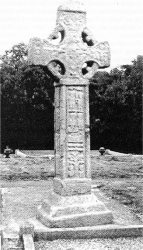
Elaborately decorated with
biblical images, Donaghmore Cross stands
prominently in the cemetery of the
Church of Ireland Parish Church.
Donaghmore Church is beautifully situated. It
surmounts a small hill or rath which nestles among the fertile hills and
rolling plains of the area. No wonder the chieftain built himself a fort
here! The fort formerly covered one and a half acres, it seems, and
there are a number of forts in the surrounding countryside. St. Patrick
may have evangelised the chief, his family and retainers who lived on
the rath and then founded a church for them. Donaghmore had its
religious community and tribal bishop, St. Mac Erc (son of the
red-haired one). Monasteries and bishoprics were adapted to the civic,
tribal conditions then prevailing in the country. St. Mac Erc appears to
have been of the family of Milchu, with whom St: Patrick was in bondage
in the valley of the Braid, near Slemish Mountain, Co. Antrim, some
decades previously.

In the Ecclesiastical Taxation of 1306, the Church of
Donaghmore was valued at 20 shillings and the name appears again and
again in the Registers of various Archbishops of Armagh in the 14th. and
15th. centuries.
Although nothing very definite is known about the
original church of Donaghmore, it is thought that it stood on the site
of the large Celtic Cross which is in the middle of the present
churchyard and that it was erected to the memory of St. Mac Erc over
1400 years ago. It followed the pattern of St. Patrick's churches,
running from east to west (like the present one), and rectangular in
shape. It was a wooden structure like all the other buildings on the
fort. In all probability, it was built of oak wood and thatched with
reeds - there was a supply of oak locally in Derrycraw and Corgary,
while the reeds were plentiful in the surrounding bogs.
St. Mary's Church, Barr
This church was built in 1830, just after Catholic
Emancipation (1829), during the pastorate of Fr. John Carter
(1825-1843). It was dedicated by Dr. Blake on 21st. June 1835. St.
Mary's, Barr was built beside the former church, which, we are told, was
on the wooded north boundary of the present graveyard, about 15 yards
from the road. There is a tradition that there was a Mass House here
before that. Was this perchance the Mass House which official records
say was built in these parts in 1701? There is no townland of Barr. The
Irish word 'Barr' means `top' and expresses very well the location as
Barr stands 385 feet above sea level and is exposed to the elements on
all sides. The present site was donated, it would appear, by the
landlord, Savage, who lived in Lurganare.
St. Mary's Church was notably repaired by Fr.
Magennis P.P. in 1903, when the original parochial house was built.
Before that time, the priests lived in Glenn. When in Barr, they had
breakfast in the upper room of the old coach house, the pillars of which
are still visible in the graveyard wall at the south end along the road.
The coach house was finally demolished in 1959.
St. Mary's Church was again extensively renovated and
the graveyard extended to the west in 1969, during the pastorate of Fr.
John McCauley. Dr. Eugene O'Doherty, Bishop of Dromore, blessed the
church. The panel then installed over the front door was executed by Mr.
Ray Carroll of Dublin. The theme of the panel is taken substantially
from the carvings of
the early Celtic Cross in Donaghmore churchyard. The
panel briefly portrays the history of salvation, beginning with the
entrance of sin in the Garden of Eden. The basic Christian rule, the Ten
Commandments is represented by the Ark of the Covenant, which is being
carried through the desert of Sinai on the forty-year journey to the
Promised Land. David, the human ancestor of the Redeemer, is also
represented with his somewhat triangular harp,. praising the God of
Israel. A Cross, raised against a darkened sun, represents the
fulfilment of the Promise and the redemption of mankind by the sacrifice
of Calvary. There is a hill on either side of the panel. The hill near
the Ark could be taken to represent Samaria and the other, Jerusalem.
They recall Our Lord's words in John 4:22, that neither in Samaria nor
in Jerusalem will you worship the Father, for the Old Law is being
replaced by the New, represented by the Cross on the hill of Calvary.
Another more simple explanation of the panel is as follows: The theme is
the Visitation - a very suitable theme for St. Mary's; Barr. Our Lady
visits her cousin, Elizabeth. David, the human ancestor of the Redeemer,
is portrayed in the background, symbolised by the harp, the crown, the
sword and the Ark of the Covenant being carried into the Citadel of
David (2 Sam.6). The hills on either side are added to fit in with hills
surrounding Barr Chapel.
The oldest inscribed and legible cross in Barr
churchyard is erected to the memory of John McEvoy, Drumiller, who died
in 1820. A feature of the graveyard is the number of fine old slate
memorial tablets, the work of John Connolly of Burren and a good example
of local craftsmanship in the last century.
The beautiful stained-glass windows on either side of
the altar were donated, as indicated on them. The elegant Sacred Heart
candelabra is of ancient vintage

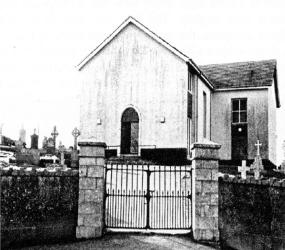
St. Mary's Church, Barr, stands
385 feet above sea level. It was extensively
renovated in 1969 and refurbished, again, in 1995.
and was donated by a donor from Colorado Springs,
U.S.A., in memory of his parents. The statues are French in origin and
are now valuable. The wood-carved Stations of the Cross were executed by
John Haugh of Newry and, after the 1969 repairs, replaced the coloured,
glazed Stations in the Irish language which had been in use until then.
In 1995, after a fire, the church was completely refurbished and nine
new inscribed stained glass windows installed.
The Church of St. John The Evangelist, Glenn
Glenn is a shortened form of Gleannagan (little
glen), which referred, it seems, to an area comprising nine or twelve
townlands, extending from Poyntzpass to Mount Mills in Drumiller.
The present Glenn Church of St. John the Evangelist
in Ballyblaugh was erected during the pastorate of Fr. John McDonnell
(1851-1870). It was begun in 1863 and stands near the site of a former
church. According to a document written by Fr. Martin Ryan PP.,
Donaghmore, dated 3rd. December 1847, the former Glenn Church took the
place of a temporary fixture which stood in former times on rising
ground adjacent to Dromantine House, which, in the language of the day,
was called `bohug,' derived from the Irish `both�g'. For historical
reasons, after 1760, generally speaking, hidden, secluded places for
Mass were no longer strictly necessary. It was rather a matter of
finding somewhere suitable to say a public Mass as churches were not
available. The `bohug' must surely have been such a place. The ground
for the first church in the Glenn was donated outright by Arthur Innes
(1755-1820), or given by him in lieu of the bohug, probably around 1800.
The site for the present building was given by Arthur Charles Innes,
later, Innes Cross (1834-1902) shortly before 1863.
The old Parochial House in Glenn was begun in 1848,
and finished in 1850. It was demolished in 1982. Its construction is
documented by Fr. Ryan P.P, in the old parochial registers. Little
remains of the old church, save a one-armed cross which surmounted it
and which is now included in the new complex. The building known as
`Glenn Loft' would seem to have used some of the window stones of the
old church.


The Church of St. John the Evangelist,
Glenn, was erected in 1863. To the right of the Church we
see an old granite cross preserved from an earlier Catholic
Church at Glenn.
Glenn Chapel is a neat, solid, stone-built, oblong
building, measuring 86 feet by 36 feet. It is, perhaps, typical of many
of the churches around Catholic Emancipation time. The clean
lines of the woodwork ceiling and supporting beams are very beautiful
and the tall Gothic windows with diamond panes, give a pleasing
cloistered effect. Glenn was renovated in 1982 by Fr. Frank Treanor and
as many as possible of the old furnishings were incorporated into the
new design. The large stained-glass window behind the altar was
presented in memory of James McCartan (of `the Fourmile') by his family.
The window depicts St. John the Evangelist holding a chalice with a
snake coming out of the chalice. The symbol refers to the legend that
St. John was at one time offered a poisoned chalice in an attempt to
take his life. The symbolic representation consists normally of a gold
chalice and a silver serpent on a blue field. On Sunday, 6th. February
1983, the Church of St. John the Evangelist was re-opened and solemnly
blessed after extensive internal and external renovations had been
completed. These included a re-designed sanctuary with a new altar,
lectern, tabernacle and celebrant's chair, new sacristies, toilets and a
large meeting room. Some historical items from the parish have been
included in the external renovations: the Mass stone in the forecourt
wall, the Mass Rock at the side of the meeting room and the granite
cross (with one arm missing), from the former church. The ceremony of
dedication was performed by Most Rev. Dr. Francis Gerard Brooks, Bishop
of Dromore. Further renovations were undertaken in 1995 when fifteen new
leaded windows, with inscribed stained glass insets, were installed.

DROMANTINE
Dromantine House and estate passed into the hands of
the Society of African Missions in April 1926 serving as a training
centre for students for the priesthood for the African Mission. In the
early 1970s, in accordance with the ideas prevailing on seminary
training, the students were transferred to a purpose-built seminary on
the Maynooth College campus. From the opening of the seminary until its
transfer, 587 Dromantine priests were ordained for the Society by Dr.
Mulhern and Dr. Eugene O'Doherty. Since 1972, as well as housing the
S.M.A. community, Dromantine College has also been a house of mission
promotion and animation and a retreat and conference centre. Major
renovations have taken place and the fine building has been restored to
its original splendour. The influence of Dromantine world-wide is our
parish example of the growth of Christianity.
The College Chapel is of simple, even austere,
exterior. Inside, there are gracefully-curved Romanesque arches
everywhere and an artistic, life-sized carving of the Saviour. The high
altar is of polished, black, Wicklow granite. The seating is oak. The
upper windows, which present fifteen of the mysteries of the Rosary, are
unique in that the figures and scenes were sand-blasted on to the glass
of these large single-paned windows. The Stations of the Cross are
carved of Austrian wood and are quite valuable. The chapel is dedicated
to St. Patrick and St. Th�r�se of Lisieux and was consecrated by the
Bishop of Dromore on the 18th. May 1937.
PARISH PRIESTS
St. Mc. Erc: Son of the Red-haired Fellow, son of Bronach,
the daughter of Milchu, the master to whom St. Patrick was sold in
bondage, was the first Christian missionary in Donaghmore. He must
have worked here in the second half of the fifth century and,
presumably, founded a church at the request of St. Patrick. Reeves,
in his `Ecclesiastical Antiquities' says that the feast of St. Erc
was formerly observed on the sixth of July.
There is, unfortunately, a break of some 900 years in the line of
succession here.
Sir John McCrela (Sir was an ancient equivalent of
Reverend), was appointed in 1408.
Rev. Gelacius O'Mackrell became rector in 1440.
Rev. John O'Mackrell was rector in 1487.
Rev. Donald O'Mackrell was vicar of Donaghmore and died in
1534.
Rev. Peter O'Mackrell succeeded Rev. Donald O'Mackrell.
In pre-Reformation times, the O'Mackrell, McCrelas, McGreals,
Mackrells etc. were Herenachs which seems to stand for land-steward,
sacristan etc. Often, some members of the Herenach's family took
Holy Orders and, in the case of the O'Mackrell family, succeeded to
the parish of Donaghmore for many years. There follows a substantial
break which would correspond roughly to the worst of the penal times
when records became very sketchy or nonexistent.
Rev. John Temsy is mentioned in the will of Arthur (Galta)
Magennis, Viscount of Iveagh, who lived in Corgary (Donaghmore). He
is mentioned as Parish Priest, presumably of Donaghmore. On the
other hand, he may have been Parish Priest in Dublin, where Arthur
Galta died on 30th. April 1683.
Rev. Iaver Magennis is also named in this will as chaplain
to Arthur Magennis.
Rev. Cormac O'Hare, a native of the parish and ordained by
St. Oliver Plunkett in 1672, was registered in Downpatrick as a
"Pretended Popish Priest" on I l th. July 1704. He was then aged 55
years and resided with his relatives.
R.ev. James McDonnell was similarly registered in 1704 as
Parish Priest of Aghaderg and part of Donaghrnore. He was 36 years
of age and lived in the townland of "Dromanteam."

According to a report submitted to the House of Lords around this
time, there were three priests residing in Donaghmore in 173 I. One
of these was, in all probability, the Parish Priest of Aghaderg and
Donaghmore. This report also states that there was a Mass House
built in the parish around 1701.
Rev. .John Malone, of Malonestown, Ballymacarattymore, was
Parish Priest of Aghaderg until he died in 1814.
Rev. James McKay, Parish Priest of Donaghmore, died in
1765. He resided in Ballyblaugh. The name of Fr. McKay's successor
is not known but a report to the House of Lords, dated 22nd. March
1766, states that there was a "Popish Priest" residing in Donaghmore
at the time.
Rev. John O'Hagan of Clonduff became Parish Priest in 1793
and died in 1810. He was educated in France, had to flee during the
French Revolution and was ordained by Dr. Lennon, Bishop of Dromore.
Rev. Patrick Cosgrove, a Newry man, was ordained by Dr.
Derry, Bishop of Dromore, in the Old Chapel, Newry and appointed
Parish Priest of Donaghmore in 1810. He died of typhus fever on 3rd.
October 1817.
Rev. Peter McCarthy, said to be a native of the parish,
succeeded Fr. Cosgrove. He died in 1825.
Rev. John Carter, a native of Newry, came next, in 1825.
He, too, was ordained by Dr. Derry. He built the church in Barr. He
died in 1843 and is interred "in the graveyard annexed to the Barr
Chapel". Some say that his grave is under the present pathway, to
the right of the church.
Rev. Martin Ryan was raised from C.C. to Parish Priest in
Donaghmore in 1843. His records of the pastoral and administrative
life of Donaghmore are very detailed, beautifully written and
preserved, and make most interesting reading. Fr. Ryan built the
Parochial House in Glenn and returned to his native Limerick in
1851, where he died as Parish Priest of Athea in 1888.
Rev. John McDonnell was appointed Parish Priest in 185 I .
He died on 21st. April 1870 and was interred in Glenn Church, which
he began building in 1863. He was known to be a great advocate of
total abstinence from alcoholic drink. No evidence of the actual
grave was recorded during the 1982 renovations.
Rev. Felix McLoughlin of Clonduff came as Parish Priest in
December 1870. The eight-month delay in his appointment was due to
the absence of Dr. Leahy, who was in Rome for the First Vatican
Council. Fr. McLoughlin died on 29th. January 1901. He, too, is
buried in Glenn Chapel, in a grave with arched cover, built by John
O'Hare, stone mason, Tullymore, which is directly beneath the first
window outside the altar rails on the B.V.M. side.
Rev. Felix Magennis became Parish Priest in December 1901.
The long vacancy in this case was caused by the death of Dr.
McGivern. In the meantime, Rev. William Maginn of Clonduff was
Administrator. Fr. Magennis began the constructing the Parochial
House in Barr in 1901 and was transferred as Administrator to
Warrenpoint in 1907.

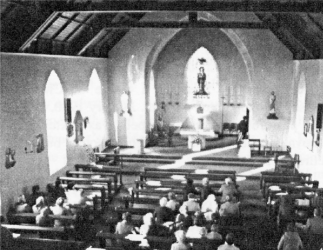
Parishioners gathered in Glenn Chapel.
Sanctuary renovations undertaken in 1982 can be
seen here.
Rev. Patrick McConville became Parish Priest of Donaghmore
on 16th. February 1907. Still affectionately remembered as Fr. Pat,
he was born in Drumgath parish, educated in the Propaganda College,
Rome and ordained in the Lateran Basilica. He was made Canon in 1925
and died on 23rd. December 1932 and is interred in Barr.
Rev. Henry McGivern succeeded Canon McConville in 1933. A
native of Annaclone and a nephew of Dr. McGivern, Bishop of Dromore,
(18901900), he was educated and ordained in Rome. He was an army
chaplain in Egypt and Palestine during the First World War. He was
made Canon in 1939 and resigned in 1952. He died in 1954 and is
interred in Barr.
Rev. Thomas Carvill was appointed Parish Priest on 11th.
November 1952. A native of Clonallon, he studied at Maynooth and the
National University of Ireland. He became a Canon in 1960. A
dedicated pastor, his main hobbies were the native language,
electronics and a study of the writings of Cardinal Newman. He died
on 29th. March 1967 and was buried in Barr.
Rev. John McCauley, a native of Ballynahinch, was Parish
Priest from 2nd. May 1967 until his retirement on 31st. December
1979. He had a distinguished career at the Irish College in Rome and
was ordained by Dr. Pasetto, Archbishop of Iconium in the Chapel of
the Leonine College in 1938. He was appointed to Donaghmore in May
1967. During his pastorate, he renovated Barr Chapel and his plans
for a major overhaul at Glenn - which is now completed - were well
advanced. His main hobby has an apostolic flavour: like the
Apostles, he is a dedicated fisherman!
Rev. Francis Treanor, a native of Clonallon Parish, was
appointed on 16th. January 1980. During his pastorate, Glenn Chapel
was extensively renovated and the new parochial house built. He
retired in August 1994.
Rev. Jarlath Cushenan, a native of Newry, was appointed
Parish Priest in August 1994. He had previously been Dean in St.
Colman's College, Newry for ten years and was, later, attached to
Seapatrick and St. Peter's, Clonallon. He resides in the new
Parochial House at Ban-, built on the site of the old house, which
was demolished.

| John McHugh, |
1835. |
| Francis J. Blake, |
1849 - 1850. |
| John McDonnell, |
1850 - 1851. |
| Michael McConville, |
1872 - 1874. |
| Stephen McAnulty, |
1874 - 1879. |
| Abraham McNamara, |
1886 - 1894. |
| Thomas McGrath, . |
1894 - 1895 |
| William MacGinn, . |
1899 - 1901 |
| Edward McConville, . |
1910 - 1913 |
| Patrick Keenan, |
1913 - 1916. |
| Patrick J. Markey, . |
1923 |
| James J. Lennon, |
1923 - 1931. |
| Aloysius J. Sweeney, |
1931 - 1934. |
| Hugh Fegan, |
1934 - 1938. |
| Edward McRory, |
1938 - 1946. |
| Charles O'Hagan, |
1946. |
| James Bernard McCartan, . |
1946 - 1952 |
| S�amus Reid, . |
1962 - 1966 |
| Patrick J. McAnuff, . |
1950 - 1956 |
| John Murtagh, |
1956 - 1958. |
| James Magee, |
1958 - 1959. |
| Anthony Davies, . |
1959 |
| Arthur McNeill, |
1959 - 1962. |
| Gerard McCrory, |
1966 -. 1967. |
| Charles Byrne, . |
1980 |

MASS STATIONS IN PENAL TIMES
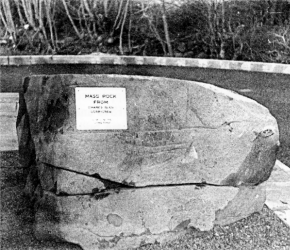
Within the grounds of Glenn Chapel
this large 'Mass Stone' has a place of honour. It
came from the townland of Derrycraw
1. Kilracan Fort is one such centre. Fr. Ryan
P.P., Donaghmore, on 3rd. December 1847, pointed out that the site
of the first Glenn Chapel was given by the Innes family, either as
"an equivalent for the temporary fixture which stood in former times
on rising ground adjacent to Dromantine House, which in the language
of the day is called a bohug and wherein our ancestors adored the
God of their forefathers, or, as a free gift and made without any
regard to the erection alluded to." Kilracan Fort is said to have
been on what is now called `the horseshoe field,' so named on
account of its shape. We think Kilracan was the site of the `bohug'
or Mass shed to which Fr. Ryan referred.
2. By the kind permission of the owners, a very large Mass Stone,
weighing about three tons has been taken from O'Hare's Glen. It has
an honoured place in the Glenn Church grounds. There are no markings
on it as, according to tradition, it dates back to the early Penal
days when there could be no indication on the stone concerning its
use.
3. According to the late great-grandfather of the present Kennedy
Family, Mass was said on Harpur's Hill in Dromantine demesne,
opposite what is now called Rice's Lane. In 1974, during repairs to
the bridge on Rice's Lane, a largish flat stone of slightly brownish
texture, weighing about 1cwt. was found in the bridge. (A similar
quality of stone is found in the quarry on the Glen river). It had a
crudely-cut cross or crosslet, about ten inches by ten inches,
sculpted on it. The sculpted cross would indicate its use as a Mass
Stone in later Penal times, probably after 1760. It is proposed that
this is, in fact, the Mass Stone used on Harpur's Hill. It was,
seemingly, at some stage built into the bridge for safe keeping. For
safer keeping, it was removed to the home of J.P. Morgan and
decoratively built into a wall there. It is now in the Forecourt of
Glenn Chapel.
4. It is said there were around Barr, at different times, two
Mass Rocks and one Mass House. One Mass Rock was in Carrickrovaddy.
It was at a spot well hidden from the Red Road and convenient to a
number of 'pads' which converged there. The other Mass Rock was
nearby, according to tradition. Here there was an outcrop of rock,
split by a stream running through it. There is now no trace of the
rocks, unfortunately. It is said that it was here, too, that the
first Catholic school after Penal times was located and that people
following the `pad' could walk from Glenn and beyond to this school
in Barr without climbing a steep hill. It would seem that, at some
time, a Mass House was built on wooded Barr Hill, perhaps in the
present cemetery. The present Church of St. Mary's, Barr was built
on approximately the same site in 1830.
5. Some people are quite definite that Mass was
said, at one period of the Penal times, on Cooley's Fort. This is a
view favoured by Dr. A. Glynn S.M.A. in Dronantine in Days Gone
By.

LOCAL LANDSCAPE
The Dane's Cast
The Dane's Cast is a notable physical feature of the
parish of Donaghmore. Why it is called the Dane's Cast is difficult to
understand as the Danes seem to have nothing to do with it. The three
brothers called the `Three Collas' came north as mercenaries of the High
King of Tara in 332 A.D. and, in a seven-day battle which was so great
that the corpses lay scattered from Drumiller to the Clanrye, defeated
Fergus, King of Ulster, and went on to take Armagh. Lurganare (`the
ridge of slaughter'), would seem to have got its name from this battle.
The remnant of Ulstermen withdrew to Down and Antrim (Ulidia) and, to
defend themselves, built a ditch and bank stretching from the Clanrye
almost to Lough Neagh. Lough Neagh and the Bann river helped in their
defence the rest of the way. This bank and ditch is commonly called the
Dane's Cast. In the parish of Donaghmore, parts of it can be seen at the
Barracks in Knockanarney and also in Dromantine townland, not far from
Dromantine back gates. A research team from the Ministry of Finance,
Belfast, worked on the latter site a few years ago. There are other
theories about the origin of the Dane's Cast but the above is the likely
one. The Irish name of the Dane's Cast seems to have been Gleann na
Muice Duibhe, i.e. `the Glen of the Black Pig.'
SCHOOLS
Barr School
There was, we are told, a Hedge School at one time in
Barr, in the Boot Field, now owned by Peter Smyth in the townland of
Knockanarney.
Barr National School
There was a school at Barr in 1820 with 80 pupils,
fees 1 l/4d. per week, the teacher being Jane Madool. The
present Barr School was founded and the building erected in 1839. There
was probably a school held at Rafferty's dwelling which was just
opposite Carraigroe on the Red Road. In 1839, another school with a
teacher's residence was built on Barr Hill. When the present new school
was built in Lurganare in 1962, the old school was sold. Miss Fegan
taught in Barr School for many years. A principal of this school, Mr.
L.Trodden, was prime mover in starting the Glenn G.A.C. (November 1931).
Mr. Donaghy was the first principal in the new Barr School (St. Mary's),
at the Carney Corner.
Derrycraw National School - Glenn School
The Derrycraw School House was erected about 1818 by
the Corrys, who owned the adjoining property. The first teacher was D.
O'Gorman, whose salary amounted to �8 per annum plus the fees of the
pupils, i.e. two pence per week each! In 1820, he had 21 Roman
Catholics, 6 Established Church children and 3 Presbyterians as pupils.
The school was connected with the National Board in 1848, as a male and
female school. Amalgamation occurred in 1889.
The following is the succession of teachers as far as
can be known from existing records:
Girls' School Mrs. Isabella Rooney, (1848-1869 and
1879-1888), Patrick Murray, (1869-1878), Daniel Byrne, (portion of
1889), James Byrne, (portion of 1889-1900). Amalgamated School: Patrick
McGennis (1891-1918) and Mrs. Ellen McGennis (1900-1918). Later teachers
(appointed January 1, 1918) were Owen Finegan (Principal) and Miss
McNulty - later, Mrs. Finegan - as assistant.
The present Glenn School, St. John's, Aughintobber, was
opened on 1st. January 1955.

Corgary - Dromantine School
There was formerly a good school in Corgary townland
known as Dromantine School. The schoolhouse, a fine, imposing building
in spacious grounds, was erected in 1847 at a cost of � 1,500 and was,
most likely, built and financed by the limes Family of Dromantine House.
It was opened as a National School in 1848. There were girls' and boys'
schools. The first teachers were Mrs. Cuthbert and her husband, who were
succeeded by Mrs. Francis and her husband. Dromantine School in Corgary
is still in existence although it has long since been unused for
educational purposes.
PARISH REGISTERS
Baptisms date from 1835.
Marriages date from 1828.
Deaths date from 1839 (with lacunae)
The Parish Registers are kept at the Parochial House,
Barr. Duplicate copies are filed in the Bishop's Archives at Newry.
THE PEOPLE
The population of Donaghmore Parish is about 1,000
and is expanding with many new houses in the area. The parish enjoys the
existence and support of groups and societies in many different fields
such as the Legion of Mary, St. Joseph's Young Priests Society, Lourdes
Committee and Apostolic Workers. Eucharistic Ministers, Readers, Choirs,
Mass Servers, Collectors and an Altar Society exist in each of the
churches.
Parishioners sit as governors for each school. The
G.A.A. has a flourishing programme in the Glenn Complex for parents and
toddlers, football for six teams from the under-10s to seniors, bowls,
the B&G Women's Group, badminton, Irish dancing, ballroom dancing,
crafts, a girls' club and a boys' club. A separate pre-school Play Group
also operates with voluntary help.
Senior Citizens are catered for by the Legion of Mary
Dawn Friendship Club which meets each month in Glenn Church meeting
room. The busy Comhaltas Gleann Branch consists of about forty musicians
with a total of about seventy singers and dancers from 4/5 year olds to
adults. Set dancing is an innovation. Parishioners are very supportive
of the S.M.A. Fathers in Dromantine, who are very much part of the
parish.
The parish is blessed by good relations with
neighbouring parishes and cross-community groups. In recent times, the
Donaghmore Heritage and Preservation Society arranged a reception for
fifty Americans who are descended from the area and invited our parish
to help and take part in the festivities which where held in Saval - our
neighbouring parish.

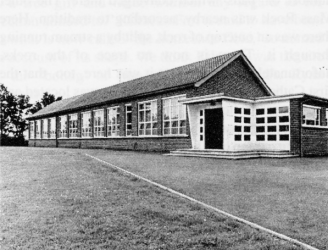
Primary Education in Donaghmore
continues to be delivered at two locations. St. John's
Primary School, Glenn (above) was built in 1954. St.
Mary's Primary School, Barr, (below), followed in 1962.

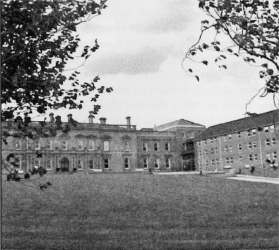
The old and the new blend at
Dromantine. This former House of Missionary Formation is
maintained by the SMA Fathers as a Retreat and
Conference Centre.
 |